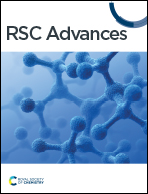Electrical field and biaxial strain tunable electronic properties of the PtSe2/Hf2CO2 heterostructure†
Abstract
The structure and electronic properties of two-dimensional vertical van der Waals PtSe2/Hf2CO2 heterostructure have been investigated based on first-principles calculations. The results show that the PtSe2 and Hf2CO2 monolayers form a type-I heterostructure with both the conduction band minimum (CBM) and valence band maximum (VBM) located at the Hf2CO2 layer. The electronic properties of PtSe2/Hf2CO2 heterostructure can be effectively adjusted by applying external electric field or biaxial strain. The transition in band alignment from type-I to type-II can be manipulated by controlling the strength and direction of the electric field. Additionally, the transition from type-I to type-II have also taken place under the strains, and the band gap of the PtSe2/Hf2CO2 heterostructure decreases with increasing the compressive or tensible strain. Under a strong strain of −8%, the PtSe2/Hf2CO2 heterostructure can transform from semiconductor to metal. These findings provide a promising method to tune the electronic properties of PtSe2/Hf2CO2 heterostructure and design a new vdW heterostructure in the applications for electronic and optoelectronic devices.



 Please wait while we load your content...
Please wait while we load your content...